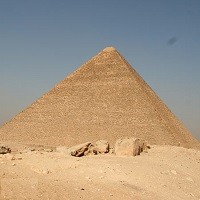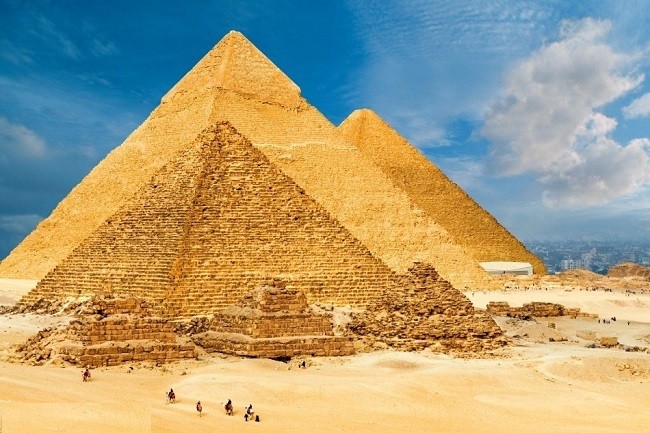
دانلود رایگان تحقیق انگلیسی اهرام ثلاثه با ترجمه فارسی
اهرام ثلاثه
نحوه ساخت اهرام ثلاثه یکی از بزرگترین اسرار مصر است.
اهرام ثلاثه برای ابدیت ساخته شده اند. مقبره های تاریخی یادگاری از دوران پادشاهی قدیم مصر هستند و حدود 4500 سال پیش ساخته شدهاند.

فراعنه مصر انتظار داشتند که در زندگی پس از مرگ خدایان شوند. به منظور آماده شدن برای دنیای بعدی، آنها معابد خدایان و مقبره های هرمی عظیمی را برای خود برپا کردند - مملو از تمام چیزهایی که هر حاکم برای هدایت و حفظ خود در جهان بعدی به آن نیاز دارد.
فرعون خوفو اولین پروژه هرم جیزه را در حدود 2550 قبل از میلاد آغاز کرد. هرم بزرگ او بزرگترین هرم جیزه است و حدود 481 فوت (147 متر) بالاتر از فلات است. تخمین زده شده که این هرم از 2.3 میلیون بلوکه سنگی که هر کدام به طور متوسط بین 2.5 تا 15 تن وزن دارند، ساخته شده است.
پسر خوفو، فرعون خفرع، دومین هرم را در جیزه در حدود 2520 سال قبل از میلاد ساخت. مقبره او همچنین شامل ابوالهول، یک بنای اسرارآمیز سنگ آهکی با بدن یک شیر و یک سر فرعون بود. ابوالهول ممکن است نگهبان کل مجموعه مقبره فرعون باشد.
سومین هرم جیزه به طور قابل توجهی کوچکتر از دو اهرام اول است. این معبد در حدود 2490 قبل از میلاد توسط فرعون منکورع ساخته شد و دارای معبد تدفین بسیار پیچیده تری است.
هر هرم عظیم تنها بخشی از یک مجموعه بزرگتر است که شامل قصر، معابد، چاله های قایق خورشیدی و سایر ویژگی ها می شود.
شکوفایی اهرام
شاهکارهای مهندسی باستان در جیزه آنقدر چشمگیر بود که حتی امروزه دانشمندان نمی توانند مطمئن باشند که این اهرام چگونه ساخته شده اند. با این حال، آنها چیزهای زیادی در مورد افرادی که آنها را ساخته اند و قدرت سیاسی لازم برای تحقق آن آموخته اند.
سازندگان، کارگران مصری ماهر و با تغذیه خوبی بودند که در یک شهر موقت نزدیک زندگی می کردند. حفاری های باستان شناسی در این مکان جذاب، جامعه ای بسیار سازمان یافته، سرشار از منابع را نشان می دهد که می بایستی توسط قدرت مرکزی قوی حمایت میشد.
این احتمال وجود دارد که جوامع سرتاسر مصر، کارگران و همچنین مواد غذایی و سایر اقلام ضروری را برای پروژه ای ملی برای نمایش ثروت و کنترل فراعنه باستان کمک گرفته باشند.
چنین افشاگری هایی زاهی حواس، دبیرکل شورای عالی آثار باستانی مصر و یکی از کاوشگران نشنال جئوگرافیک را بر آن داشته است که به این نکته توجه داشته باشد که از یک نظر این اهرام بودند که مصر را ساختند - نه برعکس.
حفظ آثار گذشته
اگر اهرام به ساخت مصر باستان کمک کردند، آن را نیز حفظ کردند. جیزه به ما اجازه می دهد تا دنیایی را که مدت هاست ناپدید شده کشف کنیم.
پیتر در مانولیان، مصر شناس موزه هنرهای زیبا، بوستون و دانشگاه تافتس، اظهار می کند: «بسیاری از مردم این مکان را فقط یک قبرستان به معنای امروزی می دانند، اما فراتر از آن است. در این مقبره های تزئین شده، صحنه های شگفت انگیزی از هر جنبه ای از زندگی در مصر باستان مشاهده میکنید، بنابراین مسئله فقط نحوه مرگ مصری ها نیست، بلکه نحوه زندگی آنها نیز مهم است.»
هنر مقبره شامل تصاویری از کشاورزان باستانی است که در مزارع خود کار میکنند و به دامداری مشغول هستند، ماهیگیری و مرغداری، نجاری، لباس ها، آیین های مذهبی و آداب و رسوم دفن نیز انجام می دادند.
کتیبه ها و متون نیز امکان تحقیق در دستور زبان و زبان مصری را فراهم می کند. در مانولیان اظهار می کند: «تقریباً هر موضوعی که بخواهید درباره تمدن فراعنه مطالعه کنید، بر روی دیوارهای مقبره جیزه موجود است.
برای کمک به دسترسی به این منابع گرانبها برای همه، در مانولیان سرپرستی پروژه بایگانی جیزه را بر عهده دارد، مجموعه عظیمی از عکس ها، نقشه ها، نقاشی ها، دست نوشته ها، سوابق اشیاء، و خاطرات هیئت اعزامی که امکان بازدید مجازی از فلات را فراهم میکند.
اسناد قدیمی تر، نقاشی ها یا کتیبه هایی را که از آن زمان محو شده اند را حفظ میکنند، مصنوعاتی را که از بین رفته یا گم شده اند و قفل مقبره هایی را که در دسترس عموم نیست را باز میکنند.
در مانولیان که با خروجی طولانی ترین کاوش های تاریخی در جیزه، موزه هنرهای زیبای هاروارد، هیئت اعزامی بوستون (1902-1947) مسلح شده است، امیدوار است محتوای بینالمللی را اضافه کند و بایگانی را به مخزن آنلاین مرکزی جهانی مطالب مرتبط با جیزه تبدیل کند. اما او تاکید می کند که هیچ چیز هرگز نمی تواند تجربه دیدار شخصی از جیزه را تکرار یا جایگزین کند.
آینده اهرام
از زمان ظهور بهار عربی در سال 2011، زمانی که مصر یک تحول سیاسی را تجربه کرد که سال ها به طول انجامید، گردشگری به این سازه ها به سرعت کاهش یافته است. این کشور از آن زمان تاکنون چندین تغییر در مدیریت داشته است و بی ثباتی به این معنی است که آینده گردشگری در اهرام نامشخص است.
منبع:
https://www.nationalgeographic.com/history/article/giza-pyramids
Pyramids at Giza
How the Pyramids at Giza were built is one of Egypt's biggest mysteries.
The Giza Pyramids, built to endure an eternity, have done just that. The monumental tombs are relics of Egypt's Old Kingdom era and were constructed some 4,500 years ago.
Egypt's pharaohs expected to become gods in the afterlife. To prepare for the next world they erected temples to the gods and massive pyramid tombs for themselves—filled with all the things each ruler would need to guide and sustain himself in the next world.
Pharaoh Khufu began the first Giza pyramid project, circa 2550 B.C. His Great Pyramid is the largest in Giza and towers some 481 feet (147 meters) above the plateau. Its estimated 2.3 million stone blocks each weigh an average of 2.5 to 15 tons.
Khufu's son, Pharaoh Khafre, built the second pyramid at Giza, circa 2520 B.C. His necropolis also included the Sphinx, a mysterious limestone monument with the body of a lion and a pharaoh's head. The Sphinx may stand sentinel for the pharaoh's entire tomb complex.
The third of the Giza Pyramids is considerably smaller than the first two. Built by Pharaoh Menkaure circa 2490 B.C., it featured a much more complex mortuary temple.
Each massive pyramid is but one part of a larger complex, including a palace, temples, solar boat pits, and other features.
Building Boom
The ancient engineering feats at Giza were so impressive that even today scientists can't be sure how the pyramids were built. Yet they have learned much about the people who built them and the political power necessary to make it happen.
The builders were skilled, well-fed Egyptian workers who lived in a nearby temporary city. Archaeological digs on the fascinating site have revealed a highly organized community, rich with resources, that must have been backed by strong central authority.
It's likely that communities across Egypt contributed workers, as well as food and other essentials, for what became in some ways a national project to display the wealth and control of the ancient pharaohs.
Such revelations have led Zahi Hawass, secretary general of Egypt's Supreme Council of Antiquities and a National Geographic explorer-in-residence, to note that in one sense it was the Pyramids that built Egypt—rather than the other way around.
Preserving the Past
If the Pyramids helped to build ancient Egypt, they also preserved it. Giza allows us to explore a long-vanished world.
"Many people think of the site as just a cemetery in the modern sense, but it's a lot more than that," says Museum of Fine Arts, Boston, and Tufts University Egyptologist Peter Der Manuelian. "In these decorated tombs you have wonderful scenes of every aspect of life in ancient Egypt—so it's not just about how Egyptians died but how they lived."
Tomb art includes depictions of ancient farmers working their fields and tending livestock, fishing and fowling, carpentry, costumes, religious rituals, and burial practices.
Inscriptions and texts also allow research into Egyptian grammar and language. "Almost any subject you want to study about Pharaonic civilization is available on the tomb walls at Giza," Der Manuelian says.
To help make these precious resources accessible to all, Der Manuelian heads the Giza Archives Project, an enormous collection of Giza photographs, plans, drawings, manuscripts, object records, and expedition diaries that enables virtual visits to the plateau.
Older records preserve paintings or inscriptions that have since faded away, capture artifacts that have been lost or destroyed, and unlock tombs not accessible to the public.
Armed with the output of the longest-running excavations ever at Giza, the Harvard-Museum of Fine Arts, Boston Expedition (1902-47), Der Manuelian hopes to add international content and grow the archive into the world's central online repository for Giza-related material. But he stresses that nothing could ever replicate, or replace, the experience of a personal visit to Giza.
The Future of the Pyramids
Tourism to the structures has declined rapidly since the advent of the Arab Spring in 2011, when Egypt experienced a political upheaval that lasted years. The country has since been through several administration changes, and the instability means the future of tourism to the Pyramids is uncertain.
Source:
https://www.nationalgeographic.com/history/article/giza-pyramids
| سر | mystery |
| اسرارآمیز | mysterious |
| پر کردن | fill |
| عظیم | massive |
| حفظ کردن | sustain |
| فلات | plateau |
| شکوفایی | Boom |
| موقت | temporary |
| جامعه | community |
| دبیر کل | secretary general |
| قدرت سیاسی | political power |
| دام | livestock |
| نجاری | carpentry |
| قدرت | authority |
| دست نوشته | manuscript |
| هیئت اعزامی | expedition |
| مخزن | repository |
| تکرار کردن | replicate |
| مدیریت | administration |
| نامشخص | uncertain |
